
 |
|
|
Please write: dan@dancooper.tv
Return to Page One
Register here to receive Fashion Finds
email updates!

 |
FF: And so your new jewelry business did well.
Rebecca Rockefeller: Yeah, surprisingly. There’s a fair in Seattle that runs every Sunday in the sort of funky arts district called Freemont. So we went to the Freemont fair every Sunday and set up a little booth, and we would basically sell out every Sunday ....
FF: No kidding.
Rebecca Rockefeller: ... whatever we brought, which actually made us feel kind of guilty, because we’d be next to people who were making like you know ten dollars, or fifteen dollars, and we were like wow! The jewelry might actually you know -- might pay our bills. This is great.
So we invested more time and energy in it, and
started getting more wholesale accounts, and applying for larger, juried shows. That was
when Five Dogs and A Hammer, which is actually my business name, started out.
 |
FF: And that was five years ago.
Rebecca Rockefeller: Yeah, it was actually.
FF: And now it’s you.
Rebecca Rockefeller: Yeah it is.
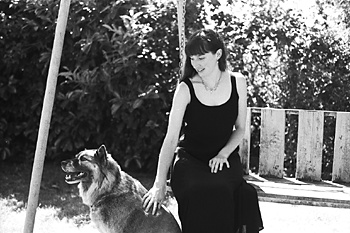 |
FF: So when did your friend move ...
Rebecca Rockefeller: My partner moved back to Tucson about a year and a half after we had started our business, and it actually felt like the entire world was falling apart. Her Dad was ill and she really wanted to be closer to her parents.
So she decided she was going to move back to Tucson, It’s very difficult to amicably separate a business partnership when it’s somebody that’s your friend that you’re in business with. And so that put a lot of stress on our friendship.
And I was in the middle of getting a divorce and
I wasn’t sure at all what I was going to do. And I was all of a sudden having to
support myself solely on my jewelry; it was a little bit stressful.
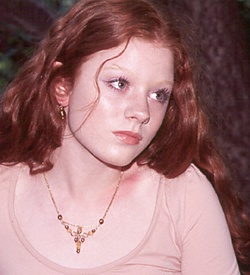 Necklace and earrings of 14K gold fill, antique satin glass, citrine, freshwater pearls, 14K gold fill chain, 24K plated sterling silver details. |
FF: And the architectural motifs and shapes and the wrought iron patterns and things that you saw in these various places, do specific ones come to mind, or is it an overall impression?
Rebecca Rockefeller: Well sometimes -- both
actually. In Saudi Arabia, and I think in pretty much every Islamic country, some time
ago, sort of in the past, they were making gratings for the outside of the windows in
womens’ quarters in their palaces; these incredible teak gratings that are hand
carved and there are these very sort of big arabesques carved in really intricately so
that people from the street level can’t see in at the women, and the women when you
look out at the world you’re looking through this amazing lacy woodwork.
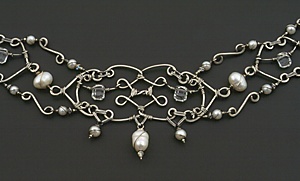 |
FF: Right, it’s the kind of thing you see at abbeys, too.
Rebecca Rockefeller: Yeah. Exactly. The same sort of thing. So I saw a lot of things like that and a lot of the little sculptural pieces that I’m shaping are based really loosely on that, on just sort of the proportions -- the negative and the positive space proportions in these gratings and the way that things interlock and weave around.
I went to Paris for a wedding. I just spent the entire time walking around just taking pictures of people’s railings. Sign posts and things.
They have those beautiful Art Nouveau metro
stations in Paris -- very botanical organic green wrought iron with glass panels in them.
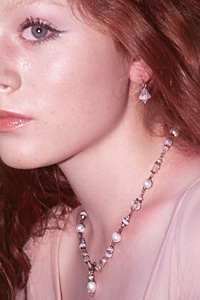 Necklace and earrings of sterling silver, freshwater pearls, Austrian crystal, antique satin glass, antique crystal, modern and antique opalescent milky glass. |
And the last time I was in New York, I spent a good bit of time out at the Cloisters (part of the Metropolitan Museum of Art, the Cloisters is a restored ancient abbey housing much of the Met’s medieval collection --Gina) staring at their little illuminated manuscript collection.
But then, I’ve also spent a lot of time in
libraries, and in the Jewish Museum (on Fifth Avenue in New York, near the Met -- Gina)
looking at old Hebrew books. And a lot of the times the fronts paper that they would lay
over basically the cover page and on the back page, would have these really beautiful
little scroll designs on them. There’s an old Hagadah (the book containing the
Passover service -- Gina). There was a prohibition against actually illustrating a
human form.
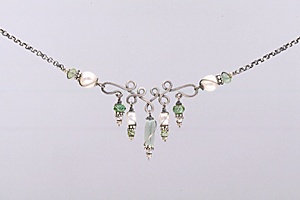 |
And so there would be animals illustrated that were in the Hagadah, along with all the text. There were a lot of really sort of decorative letters and decorative elements in the book in general because there were no other sort of human illustrations to be seen.
FF: And I think it’s very interesting that you say you don’t tend to sketch that much. That you basically just start working.
Rebecca Rockefeller: I’ve actually tried to
sketch things out beforehand, and it just doesn’t work. The whole thing is a much
more of a kinetic process for me than it is anything else. So I’ll basically just
start with -- I’ll cut off a foot long segment of thick-gauge sterling wire and
I’ll just take it with my round-nosed pliers and I’ll just start shaping it
basically.
 |
FF: And cold forged means that you shape something without heat?
Rebecca Rockefeller: Right, exactly. The techniques that I use are the same techniques that say a blacksmith would use in terms of twisting wire, folding it around itself and hammering it on to itself. But I’m using such small wire that it doesn’t need to be heated as I go along.
FF: And it’s almost like you’re connecting to the ancient ways.
Rebecca Rockefeller: People will say,
"Well, how in the world did you teach yourself to do this?" And I think, well,
if you go to the Met, and you look at their Byzantine jewelry collection, a lot of the
techniques that those pieces utilize are the same techniques that I’m using.
 |
And there’s no reason that we can’t all figure it out. I mean people figured this out so long ago. So it’s like the the world’s most basic metal working technique. So I definitely see what I do as fitting in with that whole sort of continuum of folk jewelry. People making things out of readily available materials for actual wear in everyday life.
FF: It seems in this collection that I have here, that you’re getting more and more involved with these beautiful sort of Baroque shape freshwater pearls. Is there any reason for that, or is it just that you’re drawn to pearls at the moment?
Rebecca Rockefeller: I really like them. I started out using a lot of really large antique African trade beads, and just bigger work. And I actually am really good friends with a man who imports pearls. And he got me hooked on pearls.
FF: I see.
Rebecca Rockefeller: I just love them.
FF: They are addictive, aren’t they?
Rebecca Rockefeller: Oh they’re horrible; it’s my horrible vice. I have so many. I have more than I’ll ever need. But I can’t stop buying them. I have to have more.
I love that they’re organic, and a lot of the times the ones I use are like you’re saying the more Baroque, the organic shaped ones.
FF: Oh, I love those.
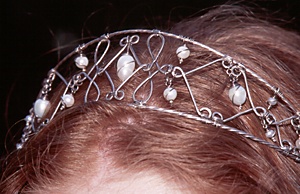 |
Rebecca Rockefeller: They’re not -- you know there’s not another one in the world quite like them anywhere, and they’re ephemeral in the overall scheme of things in that they’re not going to last forever. They’re not like a diamond.
I somehow like that idea that you have to wear them when you’ve got them, because you can’t lock them in a safe and not look at them for five hundred years. So you really have to enjoy them while you have them.
FF: Right, right. And there’s sort of something miracle-like about them; the fact that you know from a grain of sand something like that can happen.
Rebecca Rockefeller: Oh yeah.
FF: Which is true of diamonds too, but carbon is not as interesting.
Rebecca Rockefeller: Somehow it isn’t, is
it. That’s the romance of the sea.
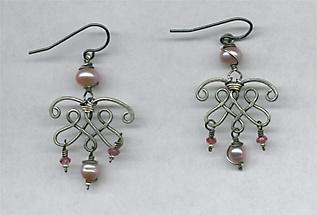 Earrings of sterling silver, freshwater pearls, garnet. |
FF: It does have the romance of the sea, it’s true. I have just one other question. You did do a lot of feminist theory work, research and study when you were in school. Is there any correlation between adornment and jewelry and feminist theory? Either your own personal philosophy, or theories you have studied and thought about, especially living in countries like Saudi Arabia where there’s such a male-centric society?
Rebecca Rockefeller: I think actually a lot of that is sort of percolating in the back of my mind. I thought originally when I was finding myself really drawn to making jewelry, I thought, oh what a bizarre thing for a feminist theory major to be making. I should start a construction company or do something like that.
And then I thought, well no, how ridiculous. This is perfect. I can deal with women all the time, and I think that there’s something -- I guess it is more my own personal theory, my own philosophy about femininity and women and people in general, not just women.
But I think that to be strong, and still perceive yourself as beautiful, is a really powerful thing. And to know that you’re a strong woman, capable of doing whatever it is you want for a living, having whatever kind of relationships you want to with the world, and that you don’t need to sacrifice the sense of beauty, and a sense of a sort of traditional Western sense of femininity in order to embody these other things.
And I think that I’m interested in kind of
giving that back to people. If you go back to the oldest archeological sites that we have,
of human goods, human property that we’ve dug up from the earth or found in a cave,
you’ll always find -- and I’m pretty sure about this, pretty much all of the
sites have beads in them.
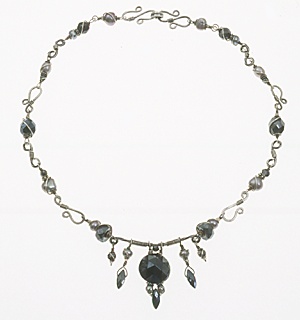 |
FF: Yes, that or jewelry. Absolutely.
Rebecca Rockefeller: And I think that
there’s something really powerful about beads, and about jewelry that has beads in
it, and just jewelry in general. I mean, even before wealth was a concept that people had,
I think it was just a way of connecting with the natural world, which I think is one of
the reasons I really like pearls, is that it’s a piece of nature basically, a little
concrete piece of this huge world that you never really internalize all of it, but by
wearing a tiny piece of it, you bring yourself into a better relationship to it.
 |
 |
|
|